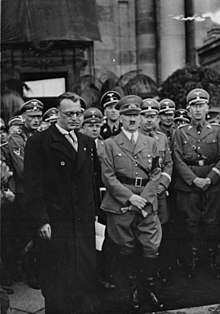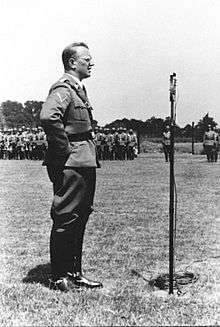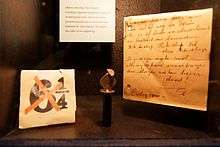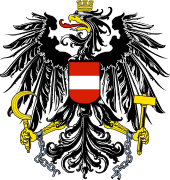Arthur Seyss-Inquart
Arthur Seyss-Inquart (German: ![]()
Arthur Seyss-Inquart | |
|---|---|
.jpg) | |
| Chancellor of Austria | |
| In office 11 March 1938 – 13 March 1938 | |
| President | Wilhelm Miklas |
| Deputy | Edmund Glaise-Horstenau |
| Preceded by | Kurt Schuschnigg |
| Succeeded by | Karl Renner (1945) |
| Reichsstatthalter of Austria | |
| In office 15 March 1938 – 1 May 1939 | |
| Leader | Adolf Hitler |
| Commissioner | Josef Bürckel |
| Preceded by | Office established (partly himself as Chancellor) |
| Succeeded by | Josef Bürckel |
| Reich Commissioner of the Netherlands | |
| In office 29 May 1940 – 7 May 1945 | |
| Leader | Adolf Hitler |
| Preceded by | Alexander von Falkenhausen as military governor |
| Succeeded by | Office abolished |
| Reich Minister of Foreign Affairs | |
| In office 30 April 1945 – 2 May 1945 | |
| Chancellor | Joseph Goebbels |
| Preceded by | Joachim von Ribbentrop |
| Succeeded by | Lutz Graf Schwerin von Krosigk |
| Personal details | |
| Born | 22 July 1892 Stannern, Margraviate of Moravia, Austria-Hungary (now Stonařov, Vysočina Region, Czech Republic) |
| Died | 16 October 1946 (aged 54) Nuremberg, Bavaria, Allied-occupied Germany |
| Political party |
|
| Spouse(s) | Gertrud Maschka ( m. after 1916) |
| Children | 3 |
| Cabinet | Seyss-Inquart |
During World War I, Seyss-Inquart fought for the Austro-Hungarian Army with distinction. After the war he became a successful lawyer, and went on to join the governments of Chancellors Engelbert Dollfuss and Kurt Schuschnigg. In 1938, Schuschnigg resigned in the face of a German invasion, and Seyss-Inquart was appointed his successor. The newly installed Nazis proceeded to transfer power to Germany, and Austria subsequently became the German province of Ostmark, with Seyss-Inquart as its governor (Reichsstatthalter).
Following the fall of the Low Countries in World War II, Seyss-Inquart was appointed Reichskommissar of the occupied Netherlands. He instituted a reign of terror, with Dutch civilians subjected to forced labour and the vast majority of Dutch Jews deported and murdered.
At the Nuremberg trials, Seyss-Inquart was found guilty of war crimes and crimes against humanity, sentenced to death, and executed.
Early life
.jpg)
Seyss-Inquart was born in 1892 in Stannern (Czech: Stonařov), a German-speaking village in the neighbourhood of the predominantly German-speaking town of Iglau (Czech: Jihlava). This area constituted a German linguistic island in the midst of a Czech-speaking region; this may have contributed to the outspoken national consciousness of the family, and the young Arthur in particular. Iglau was an important town in Moravia, one of the Czech provinces of the Austro-Hungarian Empire, in which there was increasing competition between Germans and Czechs. His parents were the school principal Emil Zajtich (who changed his surname to Seyss-Inquart) and Augusta Hirenbach. His father was Czech and his mother was German.
The family moved to Vienna in 1907. Seyss-Inquart later studied law at the University of Vienna. At the beginning of World War I in August 1914 Seyss-Inquart enlisted with the Austrian Army and was given a commission with the Tyrolean Kaiserjäger, subsequently serving in Russia, Romania and Italy. He was decorated for bravery on a number of occasions, and while recovering from wounds in 1917, he completed his final examinations for his degree. Seyss-Inquart had five older siblings: Hedwig (born 1881), Richard (born 3 April 1883, became a Catholic priest, but left the Church and ministry, married in a civil ceremony and became Oberregierungsrat (senior government counsel) and prison superior by 1940 in the Ostmark), Irene (born 1885), Henriette (born 1887) and Robert (born 1891).
In 1911, Seyss-Inquart met Gertrud Maschka. The couple married in December 1916 and had three children: Ingeborg Carolina Augusta Seyss-Inquart (born 18 September 1917), Richard Seyss-Inquart (born 22 August 1921) and Dorothea Seyss-Inquart (born 7 May 1928).
Political career and the Anschluss
He went into law after the war and in 1921 set up his own practice. During the early years of the Austrian First Republic, he was close to the Fatherland Front. A successful lawyer, he was invited to join the cabinet of Chancellor Engelbert Dollfuss in 1933. Following Dollfuss' murder in 1934, he became a State Councillor from 1937 under Kurt Schuschnigg. A keen mountaineer, Seyss-Inquart became the head of the German-Austrian Alpine Club. He later became a devotee of Heinrich Himmler's concepts of racial purity and sponsored various expeditions to Tibet and other parts of Asia in hopes of proving Aryan racial concepts and theories. He was not initially a member of the Austrian National Socialist party, though he was sympathetic to many of their views and actions.[1] By 1938, however, Seyss-Inquart knew which way the political wind was blowing and became a respectable frontman for the Austrian National Socialists.

In February 1938, Seyss-Inquart was appointed Austrian Minister of the Interior by Schuschnigg, after Hitler had threatened Schuschnigg with military actions against Austria in the event of non-compliance. On 11 March 1938, faced with a German invasion aimed at preventing a plebiscite on independence, Schuschnigg resigned as Austrian Chancellor. Under growing pressure from Berlin, President Wilhelm Miklas reluctantly appointed Seyss-Inquart his successor. On the next day German troops crossed the border of Austria at the telegraphed invitation of Seyss-Inquart. This telegram had actually been drafted beforehand and was released after the troops had begun to march, so as to justify the action in the eyes of the international community. Before his triumphant entry into Vienna, Hitler had planned to leave Austria as a pro-Nazi puppet state headed by Seyss-Inquart. However, the acclamation for the German army from the majority of the Austrian population led Hitler to change course and opt for a full Anschluss, in which Austria was incorporated into the Third Reich as the province of Ostmark. Only then, on 13 March 1938, did Seyss-Inquart join the Nazi Party.[2]
Head of Ostmark and Southern Poland
Seyss-Inquart drafted the legislative act reducing Austria to a province of Germany and signed it into law on 13 March. With Hitler's approval he became Governor (Reichsstatthalter) of the newly named Ostmark, thus becoming Hitler's personal representative in Austria. Ernst Kaltenbrunner served as chief minister and Josef Burckel as Commissioner for the Reunion of Austria (concerned with the "Jewish Question"). Seyss-Inquart also received an honorary SS rank of Gruppenführer and in May 1939 he was made a Minister without portfolio in Hitler's cabinet. Almost as soon as he took office, he ordered the confiscation of Jewish property and sent Jews to concentration camps. Late in his regime, he collaborated in the deportation of Jews from Austria.
Following the invasion of Poland, Seyss-Inquart became administrative chief for Southern Poland, but did not take up that post before the General Government was created, in which he became a deputy to the Governor General Hans Frank. He fully supported the heavy-handed policies put into effect by Frank, including persecution of Jews. He was also aware of the Abwehr's murder of Polish intellectuals.
Reichskommissar in the Netherlands

Following the capitulation of the Low Countries Seyss-Inquart was appointed Reichskommissar for the Occupied Netherlands in May 1940, charged with directing the civil administration, with creating close economic collaboration with Germany and with defending the interests of the Reich. Among the Dutch people he was mockingly referred to as "Zes en een kwart" (six and a quarter), a play on his name, and the fact that Seyss-Inquart suffered from a limp. He supported the Dutch NSB and allowed them to create a paramilitary Landwacht, which acted as an auxiliary police force. Other political parties were banned in late 1941 and many former government officials were imprisoned at Sint-Michielsgestel. The administration of the country was controlled by Seyss-Inquart himself and he answered directly to Hitler.[3] He oversaw the politicization of cultural groups from the Nederlandsche Kultuurkamer "right down to 'the chessplayers' club", and set up a number of other politicised associations.
He introduced measures to combat resistance, and when there was a widespread strike in Amsterdam, Arnhem and Hilversum in May 1943, special summary court-martial procedures were brought in, and a collective fine of 18 million guilders was imposed. Up until the liberation, Seyss-Inquart authorized about 800 executions, although some reports put the total at over 1,500, including executions under the so-called "Hostage Law", the death of political prisoners who were close to being liberated, the Putten raid, and the reprisal executions of 117 Dutchmen for the attack on SS and Police Leader Hanns Albin Rauter. Although the majority of Seyss-Inquart's powers were transferred to the military commander in the Netherlands and the Gestapo in July 1944, he remained a force to be reckoned with. It is thought he met with Haj Amin al-Husseini, an exiled leader of Palestinian Arabs, Grand Mufti of Jerusalem, somewhere in Germany in 1943.[4]
There were three concentration camps in the Netherlands: the smaller KZ Herzogenbusch near Vught, Kamp Amersfoort near Amersfoort, and Westerbork transit camp (a "Jewish assembly camp"); there were a number of other camps variously controlled by the military, the police, the SS or Seyss-Inquart's administration. These included a "voluntary labour recruitment" camp at Ommen (Camp Erika). In total around 530,000 Dutch civilians were forced to work for the Germans, of whom 250,000 were sent to factories in Germany. There was an unsuccessful attempt by Seyss-Inquart to send only workers aged 21 to 23 to Germany, and he refused demands in 1944 for a further 250,000 Dutch workers and in that year sent only 12,000 people.

Seyss-Inquart was an unwavering anti-Semite; within a few months of his arrival in the Netherlands, he took measures to remove Jews from the government, the press and leading positions in industry. Anti-Jewish measures intensified after 1941: approximately 140,000 Jews were registered, a "ghetto" was created in Amsterdam and a transit camp was set up at Westerbork. Subsequently, in February 1941, 600 Jews were sent to Buchenwald, a concentration camp located within Germany's borders, and to Mauthausen, located in Upper Austria. Later, the Dutch Jews were sent to Auschwitz, the notorious complex operated by Nazi Germany in occupied Poland. As Allied forces approached in September 1944, the remaining Jews at Westerbork were removed to Theresienstadt, the SS-established concentration camp/ghetto in the Nazi German-occupied region of Czechoslovakia. Of the 140,000 that were registered, only 30,000 Dutch Jews survived the war.
When the Allies advanced into the Netherlands in late 1944, the Nazi regime had attempted to enact a scorched earth policy, and some docks and harbours were destroyed. Seyss-Inquart, however, was in agreement with Armaments Minister Albert Speer over the futility of such actions, and with the open connivance of many military commanders, they greatly limited the implementation of the scorched earth orders.[2] At the very end of the "hunger winter" in April 1945, Seyss-Inquart was with difficulty persuaded by the Allies to allow airplanes to drop food for the hungry people of the occupied north-west of the country. Although he knew the war was lost, Seyss-Inquart did not want to surrender. This led General Walter Bedell Smith to snap: "Well, in any case, you are going to be shot". "That leaves me cold", Seyss-Inquart replied, to which Smith then retorted: "It will".[5]
Before Hitler committed suicide in April 1945, he named a new government headed by Grand Admiral Karl Dönitz in his last will and testament, in which Seyss-Inquart replaced Joachim von Ribbentrop, who had long since fallen out of favour, as Foreign Minister. It was a token of the high regard Hitler felt for his Austrian comrade, at a time when he was rapidly disowning or being abandoned by so many of his other key lieutenants in the Third Reich. Unsurprisingly, at such a late stage in the war, Seyss-Inquart failed to achieve anything in his new office.
He remained in his posts until 7 May 1945, when, after a meeting with Dönitz to confirm his rescission of the scorched earth orders, he was arrested on the Elbe Bridge in Hamburg by two soldiers of the Royal Welsh Fusiliers, one of whom was Norman Miller (birth name: Norbert Mueller), a German Jew from Nuremberg who had escaped to Britain at the age of 15 on a Kindertransport just before the war and then returned to Germany as part of the British occupation forces.[6] Miller's entire family had been killed at the Jungfernhof Camp in Riga, Latvia in March 1942.
Nuremberg trials

At the Nuremberg trials, Seyss-Inquart was defended by Gustav Steinbauer and faced four charges: conspiracy to commit crimes against peace; planning, initiating and waging wars of aggression; war crimes; and crimes against humanity. During the trial, Gustave Gilbert, an American army psychologist, was allowed to examine the Nazi leaders who were tried at Nuremberg for war crimes. Among other tests, a German version of the Wechsler-Bellevue IQ test was administered. Arthur Seyss-Inquart scored 141, the second highest among the defendants, behind Hjalmar Schacht.
In his final statement, Seyss-Inquart denied knowledge of various war crimes including the shooting of hostages, and said that while he had moral objections to the deportation of Jews, there must sometimes be justifications for mass evacuations, and pointed to the Allies forcibly resettling millions of Germans after the war. He added that his "conscience was untroubled" as he improved the conditions of the Dutch people while Commissioner. Seyss-Inquart concluded by saying, "My last word is the principle by which I have always acted and to which I will adhere to my last breath: I believe in Germany."[7]
Seyss-Inquart was acquitted of conspiracy, but convicted on all other counts and sentenced to death by hanging. The final judgment against him cited his involvement in harsh suppression of Nazi opponents and atrocities against the Jews during all his billets, but particularly stressed his reign of terror in the Netherlands. It was these atrocities that sent him to the gallows.
Upon hearing of his death sentence, Seyss-Inquart was fatalistic: "Death by hanging... well, in view of the whole situation, I never expected anything different. It's all right."[8]
Before his execution, Seyss-Inquart returned to the Catholic church, receiving absolution in the sacrament of confession from prison chaplain Father Bruno Spitzl.
He was hanged in Nuremberg Prison on 16 October 1946, at the age of 54, together with nine other Nuremberg defendants. He was the last to mount the scaffold, and his last words were the following: "I hope that this execution is the last act of the tragedy of the Second World War and that the lesson taken from this world war will be that peace and understanding should exist between peoples. I believe in Germany."
His body, with those of the other nine executed men and that of Hermann Göring, was cremated at the Ostfriedhof in Munich, and their ashes were scattered into the river Isar.[9][10][11]
Cultural references
In Doris Orgel's children's novel, The Devil in Vienna, he is the father of Lise, the only Gentile friend of its Jewish character Inge Dournenvald, and his only daughter, second born after his son, Heinz. In the Disney Channel movie, A Friendship in Vienna, based on this novel, he is Herr Mueller, played by John Hartley, the SA officer of that film.
See also
- List of SS-Obergruppenführer
References
- Snyder, Louis L. (1976). Encyclopedia of the Third Reich. McGraw-Hill. p. 320.
- "Judgement : Seyss-Inquart". The Avalon Project.
- "Biographical Sketch: Seyss-Inquart, Arthur". Donovan Nuremberg Trials Collection. Cornell University Law Library / OSS Research and Analysis Branch. 27 August 1945. Retrieved 27 October 2018.
- Aderet, Ofer (15 June 2017). "Never-before-seen Photos of Palestinian Mufti With Hitler Ties Visiting Nazi Germany". Haaretz.
- Harry L. Coles and Albert K. Weinberg (1964). "Chapter XXVIII: Piecemeal Liberation of the Netherlands Amid Serious Civilian Distress". United States Army in World War II: Civil Affairs: Soldiers Become Governors. U.S. Army Center Of Military History. Retrieved 27 October 2018.CS1 maint: uses authors parameter (link). Cf. also Dwight Eisenhower, Crusade in Europe, London: Heinemann, 1949 (third printing), p. 455
- The Flash (A Fortnightly Edition Published by The Royal Welch Fusiliers), 10 December 1945, Front Page
- "Final statement Arthur Seyss-Inquart". Go2War2.nl (in Dutch). STIWOT. Retrieved 2 October 2018.
- G. M. Gilbert, Nuremberg Diary (1947), Farrar Straus, page 433.
- Thomas Darnstädt (2005), "Ein Glücksfall der Geschichte", Der Spiegel, 13 September (in German), 14 (14), p. 128
- Manvell 2011, p. 393.
- Overy 2001, p. 205.
Further reading
- Dieter A. Binder (2010), "Seyss-Inquart, Arthur", Neue Deutsche Biographie (NDB) (in German), 24, Berlin: Duncker & Humblot, pp. 302–303; (full text online)
- Dieter A. Binder: "Seyss-Inquart Arthur". In: Österreichisches Biographisches Lexikon 1815–1950 (ÖBL). Vol. 12, Austrian Academy of Sciences, Vienna 2005, ISBN 3-7001-3580-7, p. 213 f. (Direct links to "p. 213", "p. 214")
- Graf, Wolfgang: Österreichische SS-Generäle. Himmlers verlässliche Vasallen. Hermagoras-Verlag, Klagenfurt/Ljubljana/Wien 2012, ISBN 978-3-7086-0578-4.
- Koll, Johannes: Arthur Seyß-Inquart und die deutsche Besatzungspolitik in den Niederlanden (1940–1945). Böhlau, Wien [u. a.] 2015, ISBN 978-3-205-79660-2.
- Koll, Johannes: From the Habsburg Empire to the Third Reich: Arthur Seyß-Inquart and National Socialism. In: Günter Bischof, Fritz Plasser, Eva Maltschnig (Hrsg.): Austrian Lives (= Contemporary Austrian Studies, Bd. 21). University of New Orleans Press/Innsbruck University Press, New Orleans/Innsbruck 2012, S. 123–146, ISBN 978-3-902811-61-5.
- Manvell, Roger (2011). Goering : the rise and fall of the notorious Nazi leader. London: Frontline Books. ISBN 978-1-61608-109-6. OCLC 787859366.
- Overy, Richard J. (2001). Interrogations: The Nazi Elite in Allied Hands, 1945. New York: Viking. ISBN 978-0-670-03008-8.CS1 maint: ref=harv (link)
- Zebhauser, Helmuth: Alpinismus im Hitlerstaat. Gedanken, Erinnerungen, Dokumente. Dokumente des Alpinismus, Band 1. Rother, München 1998, ISBN 3-7633-8102-3.
External links
| Wikimedia Commons has media related to Arthur Seyß-Inquart. |
| Wikiquote has quotations related to: Arthur Seyss-Inquart |
- Arthur Seyss-Inquart at the United States Holocaust Memorial Museum
- Arthur Seyss-Inquart on IMDb
- Arthur Seyss-Inquart at Find a Grave
- Newspaper clippings about Arthur Seyss-Inquart in the 20th Century Press Archives of the ZBW
| Political offices | ||
|---|---|---|
| Preceded by Kurt Schuschnigg |
Chancellor of Austria 1938 |
Vacant Title next held by Karl Renner |
| Preceded by Joachim von Ribbentrop |
Reich Minister of Foreign Affairs 1945 |
Succeeded by Count Lutz Schwerin von Krosigk |
